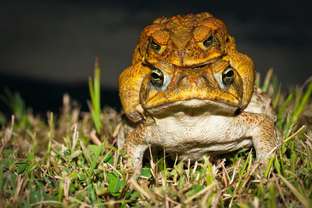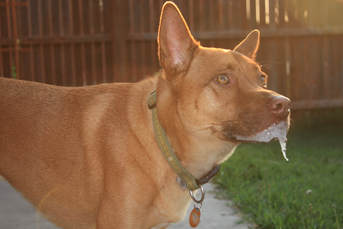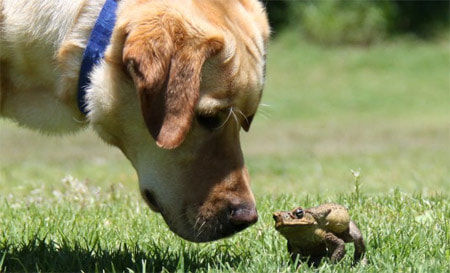The "Build-Up" is coming to the top end, and soon the tropical storms and cane toads will be upon us.
Cane toads pose a serious threat to our pets with poisonings amongst dogs now very common. Over the past two decades in Katherine, we have seen the establishment of a strong cane toad population, and new pets to the Northern Territory may not be familiar with this pest.
Cane toads pose a serious threat to our pets with poisonings amongst dogs now very common. Over the past two decades in Katherine, we have seen the establishment of a strong cane toad population, and new pets to the Northern Territory may not be familiar with this pest.
| So what makes them so toxic? Cane toads (Bufo marinarus) carry several toxins in their parotid and verrucous glands including bufotoxins, bufogenins and amines – some really nasty stuff. When a dog bites down on a toad, these toxins are released from these glands and they pass very quickly through the surface of the mouth. The toxins can affect the heart and nerves. One full grown toad has enough toxin to kill at least 100 medium sized dogs. |
What are the Signs of Cane Toad Poisoning?
Signs of cane toad poisoning in your dog will initially appear as profuse salivation (frothing), head shaking and pawing at the mouth. If it is not treated or your dog receives a large enough dose, it can progress to vomiting, weakness, seizures, and eventually death. This all can happen within an hour.
Signs of cane toad poisoning in your dog will initially appear as profuse salivation (frothing), head shaking and pawing at the mouth. If it is not treated or your dog receives a large enough dose, it can progress to vomiting, weakness, seizures, and eventually death. This all can happen within an hour.
| What Can I do? It is not all bad news. If your dog is exhibiting only mild signs such as frothing at the mouth, the most important thing you can do is to wash their mouth out for several minutes with water and rub it with a cloth. Make sure you don’t point the hose to the back of their throat or you can drown your dog, so hold their head down. IF, however, your dog starts to have seizures, seek veterinary help immediately!!! Generally the outcome is good with early intervention. |
Be careful, there are a few dodgy urban myths about toad poisonings. The most concerning one is that giving the dog activated charcoal can help. This is not true because the toxin is absorbed through the roof of the mouth. The charcoal will have no effect on the absorbed toxin. If the dog is shaking or having seizures and is fed charcoal, the dog may accidentally inhale the charcoal and this will cause dangerous breathing problems.
It is recommended that once treated, your dog be checked over to ensure there are no after effects. If you are a long way from a vet, you should still call one as soon as possible to get any further advice.
It is recommended that once treated, your dog be checked over to ensure there are no after effects. If you are a long way from a vet, you should still call one as soon as possible to get any further advice.
What if my dog swallows a cane toad?
The good news is that stomach acid deactivates the cane toad toxin. So if your dog has swallowed a cane toad whether it is fresh or dried, unless the toxin touched the inside surface of his/her mouth, they will be fine (unless the toad is off - then there could be a case of food poisoning.)
The good news is that stomach acid deactivates the cane toad toxin. So if your dog has swallowed a cane toad whether it is fresh or dried, unless the toxin touched the inside surface of his/her mouth, they will be fine (unless the toad is off - then there could be a case of food poisoning.)
Last but not least..
One last bit of advice… if you are unfortunate enough for your dog to go through a poisoning episode, after your dog recovers, please get rid of the toad. Preventing contact with toads is often difficult. Some animals will learn to avoid them as the poison doesn’t taste very nice, others will keep going back. One colleague in North Queensland had the same dog come in four times in the one night for toad poisoning. So, if you see your pet playing with a toad you should remove the toad immediately, and observe your pet closely for at least the next hour. Drinking bowls should be placed up off the ground and checked and changed regularly or a safer alternative is small automatic waterers mounted off the ground.
Lets just hope they find a way to get rid of these toads soon.
One last bit of advice… if you are unfortunate enough for your dog to go through a poisoning episode, after your dog recovers, please get rid of the toad. Preventing contact with toads is often difficult. Some animals will learn to avoid them as the poison doesn’t taste very nice, others will keep going back. One colleague in North Queensland had the same dog come in four times in the one night for toad poisoning. So, if you see your pet playing with a toad you should remove the toad immediately, and observe your pet closely for at least the next hour. Drinking bowls should be placed up off the ground and checked and changed regularly or a safer alternative is small automatic waterers mounted off the ground.
Lets just hope they find a way to get rid of these toads soon.
Dr Alex Burleigh BSc(Vet) BVSc
Dr Alex Burleigh is based in Katherine, NT at Katherine Veterinary Clinic, part of Northern Territory Veterinary Services. He is a part owner and one of the senior veterinarians at both Katherine Veterinary Clinic and Alice Veterinary Centre. Dr Alex Burleigh is a published author with works appearing in veterinary texts, scientific journals and online websites. He consults regularly at both practices.




 RSS Feed
RSS Feed